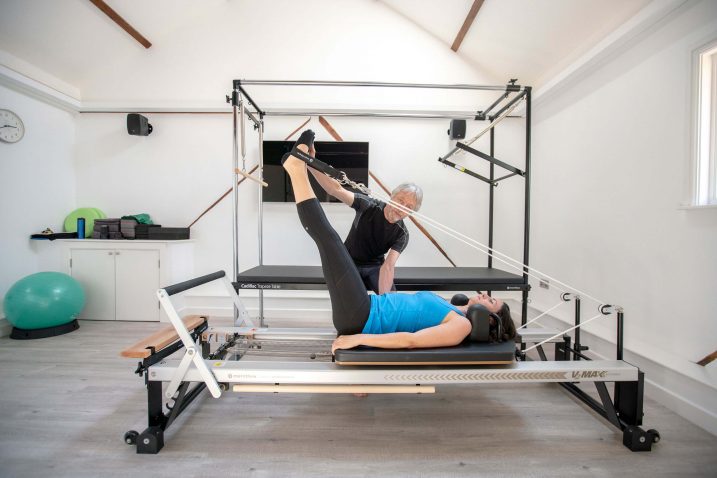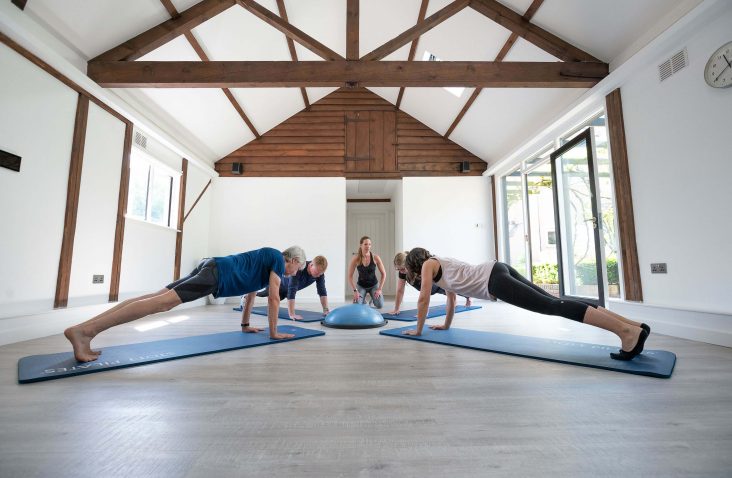Pilates
We are lucky enough to have an amazing instructor here at The Form in Tia Boorman. Click on Tia’s name to read more about her and why she is so passionate about pilates.
What do we offer & why do Pilates with us:


- Studio equipment and reformer pilates on a 1-1 basis with Tia
- If you have a complicated injury and are worried about exercise then this is perfect for you. This type of pilates and Tia’s training make this type of pilates very effective for rehabilitation. You are welcome to see one of our osteopaths or physio in advance and they can liaise with our instructors if you feel this might be helpful also.
- A luxurious and tranquil setting, making you feel better as soon as you walk through the door.
- Use of the Solrox Salt lamp for free in reception while you wait.
- All brand new state of the art equipment provided.
- Filtered water available in reception.
- Music by Wholetones in the background, specifically designed for body frequency healing.
Bookings:
For online bookings please click here. Or to make an enquiry please don’t hesitate to call us for more information on 01954 214473.
What is pilates?
Pilates aims to strengthen the body in an even way, with particular emphasis on core strength to improve general fitness and wellbeing.
Pilates exercises are done on a mat or using special equipment, such as the Reformer, Cadillac and Wunda Chair. With its system of pulleys and springs, handles and straps, the apparatus can provide either resistance or support, depending on your needs.
Pilates was developed by German-born Joseph Pilates, who believed mental and physical health were closely connected. His method was influenced by western forms of exercise, including gymnastics, boxing and Greco-Roman wrestling. Pilates immigrated to the US in the 1920s and opened a studio in New York, where he taught his method, which he called “contrology” – for several decades.
Polestar takes the original Pilates principles and provides teachers with science-based techniques to assess the whole person. Using this knowledge teachers can help clients achieve their goals to enjoy a healthy, active lifestyle. This is achieved by addressing health and fitness issues associated with sedentary habits, or chronic problems stemming from injury or surgery.
Who is pilates for?
Pilates has something to offer people of all ages and levels of ability and fitness, from beginners to elite athletes. The apparatus can be used to provide support for beginners and people with certain medical conditions, as well as resistance for people looking to challenge their body.
What are the health benefits of pilates?
There are many reports on the health benefits of pilates. However, few of these have been subjected to rigorous scientific examination, and there’s a need for more research in this area.
Practitioners say regular pilates can improve posture, muscle tone, balance and joint mobility, as well as relieve stress and tension. For elite athletes, including dancers, pilates can complement training by developing whole-body strength and flexibility, and help reduce the risk of injury.
Can pilates help reduce back pain?
There is evidence that pilates can provide pain relief to people with non-specific lower back pain. The use of apparatus enables someone with back pain to perform exercises with support.
For the exercises to be effective, they need to be tailored to the individual and vetted by an appropriately qualified health professional. Pilates teachers are not medically qualified and cannot prescribe, treat or offer therapy.
Can pilates help me lose weight?
Pilates is classed as a muscle-strengthening activity, which can help you maintain a healthy weight. Classes can vary in intensity: they can be gentle, or dynamic and offer a solid workout.
If you want to lose weight, you’re advised to combine pilates with a healthy diet and some aerobic activities, such as swimming, walking and cycling.
Can I injure myself doing pilates?
Pilates is a low-impact form of exercise, so injuries are uncommon. However, it’s important to find a qualified teacher and a class suited to your level of fitness and ability.
Pilates teachers are not medically qualified so, if you’re recovering from injury, you’re advised to check with your Osteopath, Physio or GP on the suitability of certain exercises or movements before starting a class.
What’s the difference between pilates and yoga?
While the methods are different, pilates and yoga both develop strength, balance, flexibility, posture and good breathing technique.
Both systems emphasise the connection between physical and mental health, although yoga places more emphasis on relaxation and uses meditation. Pilates is performed both on apparatus and mats, whereas classic yoga doesn’t require any equipment.
Pilates exercises are performed in a flow of movement without the static poses associated with yoga.
What’s the difference between apparatus and mat work?
Joseph Pilates originally devised more than 500 exercises for his system, of which 34 were mat exercises.
Mat work may involve traditional pilates equipment, such as magic circles or hand weights, as well as non-pilates gear, such as stretch bands, gym balls and foam rollers. Pilates with apparatus uses equipment designed by Joseph Pilates, such as the Reformer, Cadillac, Wunda Chair, Spine Corrector and Ladder Barrel.
Mat and apparatus pilates can be adapted to suit different levels of fitness and ability. However, if you cannot lie down on a mat for whatever reason, the apparatus can provide alternative ways to exercise.
